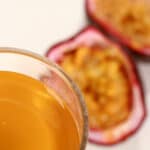Homemade Passionfruit Wine
If you can get your hands on passionfruit puree, you should definitely consider making some passionfruit wine. Easy to make, delicious!
Servings: 1 Gallon
Calories: 8282kcal
Cost: $35
Equipment
- Large pot
- Slotted Spoon
- 2 gallon fermenter bucket and lid
- 1 air lock and stopper
- Long spoon / paddle
- 2 1 gallon carboys
- Siphon, siphon tubing.
Ingredients
- 4.75 lb passionfruit puree
- 8 cups Granulated Sugar
- 12 cups Water
- 1 teaspoon yeast nutrient
- ½ teaspoon pectic enzyme
- Red Star “Premiere cuvee” yeast
Instructions
- If frozen, defrost your passionfruit puree.
- Combine passionfruit, sugar, and water in a large pot. Heat over medium until just before it starts boiling.
- Once mixture starts bubbling, turn the temp to low and simmer for 30 minutes. Think more “keep it warm”, than any kind of active simmer.
- While the pot is simmering, prepare your fermenter bucket: Wash and sanitize a 2 gallon plastic fermenter, lid, stopper, and air lock.
- Place yeast nutrient and pectic enzyme into the plastic fermenter. Affix the stopper to the lid of the fermenter, cover and set aside.
- Once the 30 minutes are up, cover the pot, remove from heat, allow to cool. It doesn’t have to be all the way to room temperature, just cool enough that if it splashes on you, it won’t hurt - that’s a good guideline!
- Once cool, carefully pour passionfruit mixture into the fermenter.
- Affix air lock to lid, cover the bucket, and allow to fully cool over night. For the sake of consistency in readings - and therefore accuracy in ABV calculations - this should be done where you plan to let the wine ferment for the next few months - usually a basement.
- The next morning, check the Specific Gravity and write it down in your notes, along with the date (optional)
- Add yeast to the fermenter bucket, stir with a long, sanitized spoon. Affix the lid, allow to sit for 24 hours.
- The next day, check to make sure that the yeast has started fermenting - there should be bubbles in the airlock, and/or foam in the liquid. Put the lid back on, allow to ferment for one week.
- After a week or so, use your sanitized siphon setup to rack the must into a freshly sanitized carboy. Put the carboy somewhere cool (not cold!), and leave it alone for a month or so.
- Using sanitized equipment, rack the wine off the sediment, into a clean, freshly sanitized carboy. Cap with sanitized airlock, leave it alone for another 1 month.
- Rack one more time, leave it for another 2 months or so.
- When your wine has been racked a few times and shows NO more fermenting activity for a month or so (no bubbles in the airlock, no more sediment being produced, you can move on to back sweetening and bottling.
- Follow the instructions on your selected type of wine stabilizer to stop fermentation from restarting. For potassium sorbate, this needs to be done 2-3 days before bottling.
- Take a gravity reading if applicable, then back sweeten as desired, using sanitized equipment.
- Using sanitized equipment, rack the wine into clean, sanitized bottles. Cork.
Notes
IMPORTANT:
Software generates nutritional information based on the ingredients as they start, and is unable to account for the sugars consumed in the fermentation process.
As such, the calories, sugars, and carbs are shown WAY higher than reality. Additionally, the listed value is for the entire recipe, NOT per serving.
Nutrition
Calories: 8282kcal | Carbohydrates: 2103g | Protein: 47g | Fat: 15g | Saturated Fat: 1g | Polyunsaturated Fat: 9g | Monounsaturated Fat: 2g | Sodium: 761mg | Potassium: 7530mg | Fiber: 224g | Sugar: 1838g | Vitamin A: 27406IU | Vitamin C: 646mg | Calcium: 360mg | Iron: 35mg
